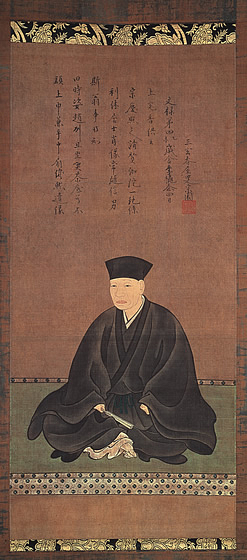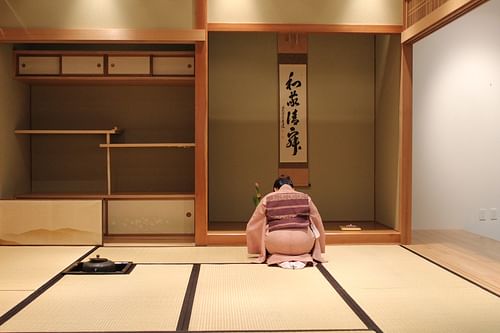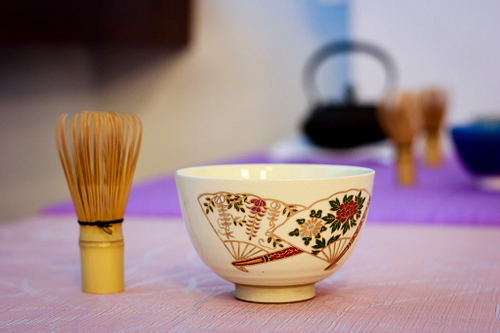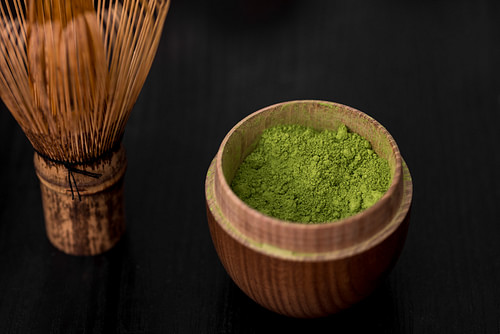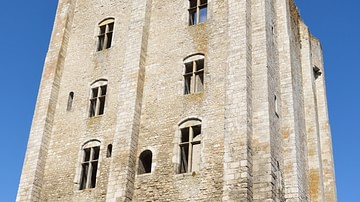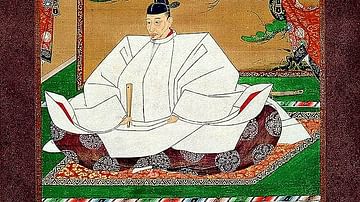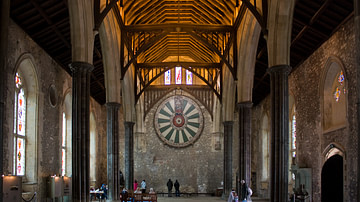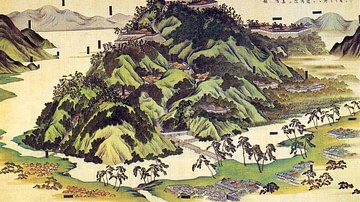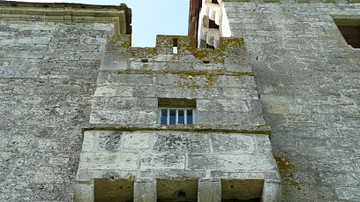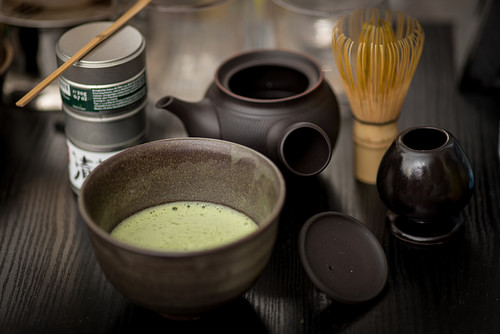
The Japanese Tea Ceremony (chanoyu or chado) is a cultural tradition involving very particular places, procedures, and equipment for drinking green tea. Originating as a habit of Chinese Buddhist monks to aid their meditation, tea-drinking in Japan and other parts of East Asia became such a refined activity that, from the 13th century CE, aristocrats adopted it as a means to display one's culture. With a specifically designed room, landscaped garden, and fine porcelain all becoming essential components of the ceremony, drinking tea became nothing less than an art form.
Origins & Developments
Tea-drinking began in China, and its discovery is credited to the Indian sage Bodhidharma (aka Daruma), the founder of Chan Buddhism, a precursor of Zen Buddhism. From the 2nd century BCE, Buddhist monks began to drink tea to help support themselves while they meditated and to ward off sleep. However, it was not until the Tang Dynasty (618-907 CE) that tea-drinking spread to the aristocracy, the only people who could afford such an expensive drink. From China, the habit spread along with other ideas via traders, diplomats, and visiting monks so that eventually it reached Japan in the 8th century CE, evolving into a whole cultural experience from the 13th century CE onwards.
In Japanese, the tea ceremony is called chanoyu, meaning 'hot water for tea', or chado or sado, meaning 'way of the tea', tea being cha in Japanese. The word 'ceremony' is something of a poor translation in English because it implies a certain formality which is something tea connoisseurs wish to avoid. Indeed, at least initially, secular tea parties were far removed from their tranquil beginnings at Buddhist monasteries and were often quite rowdy affairs where the game of guessing exactly what tea was being drunk was a popular element. This all changed when the 15th-century CE shogun Ashikaga Yoshimasa (r. 1449-1473 CE) made the whole thing a much more sober and subdued event.
The trend was set which would last until today - the tea ceremony had become the ultimate setting for discretely displaying one's knowledge of the intricacies of the procedures involved and a moment to demonstrate one's connoisseurship of porcelain and other decorative objects involved in the ceremony. It also provided a genteel setting for discrete conversation on sensitive subjects. The whole experience was meant to involve a spiritual element, a shared moment of calm and renewal for its participants. As the old Japanese saying goes, cha-Zen ichimi or "Zen and tea have the same flavour."
One of the most influential figures on the evolution of the tea ceremony was the 16th-century CE monk and tea master Sen no Rikyu (1522-1591 CE). Rikyu made the whole thing even more genteel, down-sized the tea room to make it more intimate, and added such now essential additional elements as perfectly arranged flowers. Rikyu was typical of the tea masters of medieval Japan who served as important advisors to rulers - not only on ceremonial etiquette but also politics - and who often acted as official ambassadors, diplomats and negotiators. Rulers and warlords used the tea ceremony itself for their own political encounters and bestowed upon favoured underlings gifts of priceless articles such as fine Chinese and Korean porcelain tea bowls.
By the 17th century CE, the tea ceremony had become so popular that everyone was getting involved, not just the upper classes. The ceremony was now firmly established in Japanese culture and came to epitomise four essential qualities of everyday life in Japan, as here summarised by the historian W. E. Deal:
- wa (harmony) - a desire for reciprocity, both at the tea gathering and in the outside world
- kei (respect) - awareness of one's individual role and responsibilities and appropriate decorum
- sei (purity) - a commitment to preserve social and spiritual integrity
- jaku (elegance and tranquillity) - savouring the transient moment to gain renewal (305)
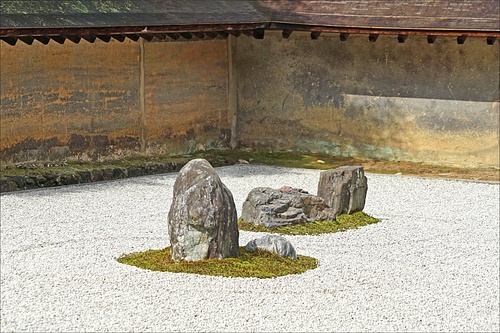
Tea Rooms & Gardens
The first and most essential element for the medieval tea ceremony was a dedicated space in the home to conduct it. This is the tea room or chashitsu, also known as a sukiya or 'house of the imperfect', alluding to the structure's original simple architecture and basic materials. These rustic buildings with roofs made of bamboo or thatch with unworked wooden columns and earth walls were separate from the main residence; one reason why the whole ceremony became the exclusive pastime of the aristocracy because only they could afford such a place. By having a dedicated room, the tea-drinkers could more easily detach themselves from their everyday cares.
A tea house was not large, perhaps only three square metres and almost completely empty. There might be a toilet in a separate room and light came from windows and through paper screens. The flooring consisted of tatami matting. One entered through a small door only 90 cm (3 ft) in height which necessitated bending down and so signified all who entered were equal as far as the tea ceremony was concerned. Before one entered one had to wash one's hands in the stone basin (chozu-bachi) provided for that purpose. Another typical feature was a stone, free-standing lantern, also outside.
The interior of the medieval minimalist tea room/house would be copied in private homes right down to today. Inside, one might have flowers and these would be displayed according to the aesthetic principles which prevail in Japanese flower arranging, itself an art form and known as ikebana. The flowers or grasses are selected according to the season and are placed in a vase (hanaire) made from bronze, copper, porcelain or bamboo. There should, too, be a painting (jiku) on a silk hanging scroll. Again, the choice of a suitable subject would reflect on the connoisseurship of the tea host with landscapes being favoured or a fine example of calligraphy. A final touch might be an incense jar. All of these decorative elements together should provide a harmonious and calming atmosphere.
A great help in achieving the desired atmosphere of tranquillity is to provide the tea room with the correct sort of view. The preferred panorama is of an immaculately tended landscape garden. An alternative type is the Zen rock garden which is a hyper-minimalist dry landscape garden (karesansui) consisting only of immaculately raked sand or gravel and a few choice stones. Finally, a third type of garden was designed not for looking at but for calming the guests on their way to the medieval tea house (or the modern equivalent for those with the outdoor space). This small garden or cha-niwa, typically has a stepping stone path (tobi-ishi) leading from the main house. The desired greenery is evergreens rather than flowers, and then moss or soft grass underfoot to begin the calming effect of the ceremony before it has even started.
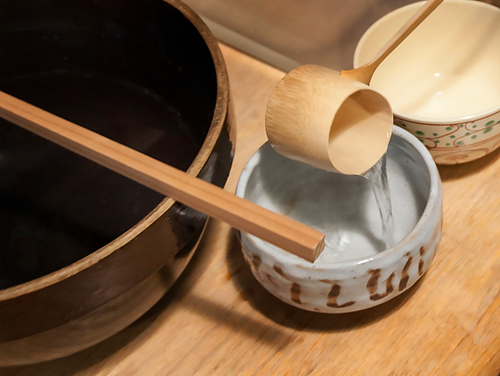
Porcelain & Implements
The garden and the tea room may have been difficult to acquire and maintain but simply getting together all the correct implements needed for tea-drinking was no easy feat either, then or now. In medieval Japan, tea was usually prepared by pounding the leaves and making a ball with amazura (a sweetener from grapes) or ginger, which was then left to brew in hot water which had usually been boiled in an iron kettle over charcoal. The tea was strong, green, and bitter, but a taste balance could be achieved by providing drinkers with small sweets. The green tea used today is matcha and is of the highest quality. The leaves are typically dried, ground into a very fine powder and then sprinkled and whisked into the hot water. Proportions and methods of preparation vary, though, as specialised tea schools were opened and each one had their own preferred approach which many still follow today. One thing that most drinkers agree on is that the host should make the tea themselves, helping foster a greater atmosphere of intimacy.
All of the equipment used in the tea ceremony should be of the very highest quality. Not only fine porcelain but even antique collector's pieces were and still are used for the vessel or chawan from which the tea is drunk. One might use fine lacquerware or a beautifully carved bamboo implement or a kettle of exquisitely worked metal - all of these details would be noticed by the guests. Objects should be beautiful but also simple and thereby exhibit the important Japanese aesthetic principle of wabi. Another desirable quality to foster is sabi, that is the faded beauty seen in much-loved and well-used objects which acquire a unique patina that only time can give.
The essential utensils (chadogu) used in the tea ceremony are:
- Portable Brazier (furo) - used for smaller kettles and when a fire is not available such as in the summer months. The brazier can be made of anything and may be placed on a special iron tile on the floor, a shikigawara.
- Kettle (kama) - used only to boil water and not receive any tea itself. Iron is the most common material although some are made using gold or silver. The shape is not particularly important except that it follows the aesthetic principles already mentioned.
- Rest for the Kettle Lid & Water Ladle (futaoki) - coming in many forms but often a simple bamboo mat.
- Fresh Water Jar (mizusashi) - made from wood, porcelain or metal, it is used to cool water in the kettle or wash vessels and utensils.
- Tea Cloth (chakin) - a piece of linen or silk used to wipe rinsed bowls and utensils.
- Water Ladle (hishaku) - of various types depending on the cut of their handles.
- Wastewater Bowl (kensui) - to receive the wastewater after cleaning the bowls and utensils.
- Tea Caddy (chaire / natsume) - there are two types of caddy; one for thick or stronger tea (chaire) which is usually kept in small silk bags (shifuku) and one for thin or weaker tea (natsume). Porcelain with an ivory lid are the favoured materials.
- Tea Scoop (chashaku) - used to take tea from the caddy, it may be made of any material.
- Bamboo Whisk (chasen) - for whisking the mixture of tea and water.
- Tea Bowl (chawan) - coming in all shapes, sizes, decoration, and material, these display the personal taste of the host but may reflect the season or the guest's preferences or even the level of formality the host desires to achieve.
Procedure
Having got everything right in terms of setting and paraphernalia as noted above, one then has to do what all this has been leading up to: make tea. The exact movements of the host are vital but depend on which school of tea ceremony one favours. The important thing is to only make the minimum of movements which should be precise, graceful, and restrained. Further, one should be silent when actually preparing the tea. All the necessary equipment should have already been laid out before the guests, and only the kettle is hidden from their view. The tea caddy and bamboo scoop are first cleaned with a cloth. When ready, the hot water is poured into the tea bowls but only enough to warm them. Powdered tea is then added to the bowls, which are then topped up with hot water, and the mixture is whisked to make a frothy drink. The tea should be drunk in small sips. When everyone has finished, the implements and bowls are cleaned and removed from sight leaving only the kettle before the hopefully now well-satisfied guests. Finally, some of the finer implements may be returned in order for the guests to discuss their appreciation of them.
This content was made possible with generous support from the Great Britain Sasakawa Foundation.
